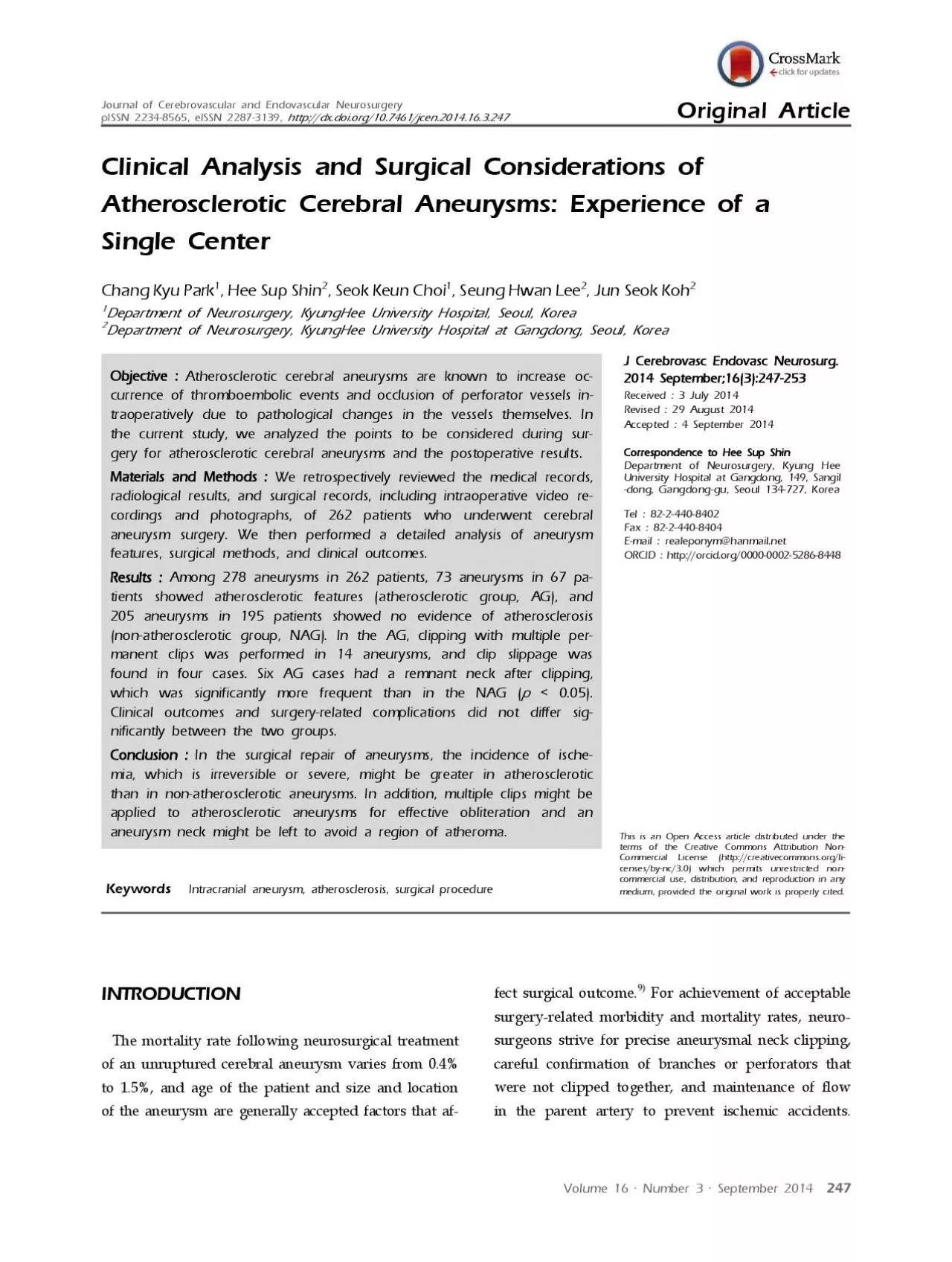

A therosclerotic Cerebral Aneurysms Experience of a Single CenterChang Kyu Park Hee Sup Shin Seok Keun Choi Seung Hwan Lee Jun Seok KohDepartment of Neurosurgery KyungHee University Hospital Se ID: 936480
Download Pdf The PPT/PDF document "Volume 16 Number 3 September 2014 Cli..." is the property of its rightful owner. Permission is granted to download and print the materials on this web site for personal, non-commercial use only, and to display it on your personal computer provided you do not modify the materials and that you retain all copyright notices contained in the materials. By downloading content from our website, you accept the terms of this agreement.
Volume 16 · Number 3 · September 2014 Clinical Analysis and Surgical Considerations of A therosclerotic Cerebral Aneurysms: Experience of a Single CenterChang Kyu Park, Hee Sup Shin, Seok Keun Choi, Seung Hwan Lee, Jun Seok KohDepartment of Neurosurgery, KyungHee University Hospital, Seoul, Korea Objective:Atherosclerotic cerebral aneurysms are known to increase oc-currence of thromboembolic events and occlusion of perforator vessels in-traoperatively due to pathological changes in the vessels themselves. In the current study, we analyzed the points to be considered during sur-gery for atherosclerotic cerebral aneurysm
s and the postoperative results. Materials and Methods:We retrospectively reviewed the medical records, Cerebrovasc Endovasc Neurosurg. 2014 September;16(3):247-253Received : 3 July 2014Revised : 29 August 2014Accepted : 4 September 2014Correspondence to Hee Sup ShinDepartment of Neurosurgery, Kyung Hee University Hospital at Gangdong, 149, Sangil -dong, Gangdong-gu, Seoul 134-727, KoreaTel : 82-2-440-8402Fax : 82-2-440-8404E-mail : realeponym@hanmail.netORCID : http://orcid.org/0000-0002-5286-8448 rovided the ori g inal work is p ro erl cited.KeywordsIntracranial aneurysm, atherosclerosis, surgical procedure J ourna
l of Cerebrovascular and Endovascular NeurosurgerypISSN 2234-8565, eISSN 2287-3139, http://dx.doi.org/10.7461/jcen.2014.16.3.247Original Article INTRODUCTIONThe mortality rate following neurosurgical treatment of an unruptured cerebral aneurysm varies from 0.4% to 1.5%, and age of the patient and size and location of the aneurysm are generally accepted factors that af- SURGICAL CONSIDERATIONS OF ATHEROSCLEROTIC CEREBRAL ANEURYSM 248 J Cerebrovasc Endovasc Neurosurg Fig.1.Operative view of an aneurysm with atherosclerotic wall. (A) Atherosclerotic change in the parent artery and aneurysmal neck. (B) Atherosclerotic c
hange in the parent artery and aneurysmal wall.Atherosclerotic changes in the intracranial artery and in part of the aneurysm result in diminished flexi-bility of the vessel itself, which not only makes the surgery difficult to perform but can also result in un-expected ischemic complications such as thromboemb-olism and vessel occlusion. In the current study, we analyzed and reported the clinical features of athero-sclerotic intracerebral aneurysms treated at our center.MATERIALS AND METHODSSubjectsCases of 262 patients who underwent aneurysmal neck clipping surgery at our center between June 2004 and November 2010 were
analyzed retrospectively. We reviewed intraoperative videos; microscopic pho-tographs; pre- and post-operative findings of com-puted tomography angiogram (CTA), magnetic reso-nance angiogram (MRA), and digital subtraction an-giogram (DSA); and medical and surgical records. We divided the patients into two groups: the athero-sclerotic group (AG) with atherosclerotic appearance of vessels, and the non-atherosclerotic group (NAG) without atherosclerosis.Evaluation of atherosclerotic aneurysmThe criteria for atherosclerotic aneurysm were assessed according to the surgeons' intraoperative findings, ei-ther retrospectively or
prospectively. Atherosclerotic changes in the vessel or aneurysm walls were identified as follows: (1) yellowish and/or whitish spotty appear-ance of the vessel and/or aneurysm; (2) surgical con-firmation of a definite decrease in elasticity of the wall, with or without a color change of the vessel (Fig. 1).Atherosclerosis types were divided according to the following categories based on the position of the athe-rosclerotic changes: (1) parent artery and aneurysm neck; (2) aneurysm neck; (3) aneurysm neck and dome; (4) aneurysm dome. Location in the parent ar-tery was defined as atherosclerotic change within 5 mm from t
he neck of the aneurysm.Evaluation of surgical resultClinical outcome was determined according to scoring and changes on the Glasgow outcome scale (GOS). The outcome was determined as favorable if the GOS score was either unchanged, regardless of the preoperative status, or improved to a GOS score of 4-5. An out-come was considered unfavorable if there was deteri-oration to a GOS score of 1-3. In addition, the occur-rence of new postoperative ischemia was assessed with a head computed tomography (CT) scan. The postoperative CT was analyzed for territory infarction or perforator infarction in relation to the clip position